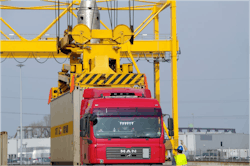Improper moving and storage of heavy equipment can cause damage and mechanical faults, which then could cause project delays and a number of other issues.
Here are a few tips from A-1 Auto Transport for transporting equipment.
1. Avoid wide-load designations
Equipment such as crawler dozers, wheel loaders, motor graders, and scrapers may be classified as a wide load in your state or municipality, which can require you to pay extra to a hauling company plus obtain extra permits. You can avoid this by shipping your equipment wisely.
Chris Ward is marketing manager for A1 Auto Transport
Height. If transporting a crane or an excavator, or any other piece of equipment with a large or tall boom or bucket, consider retracting it completely or removing it entirely. This may be enough to avoid designating the unit as an oversize load. In most cases, it’s worth sending two shipments separately to avoid wide-load designation.
Weight. Any load over 40,000 pounds is pushing the limit of an oversize load, depending on the state. Again, removing accessories and attachments from the equipment and hauling them separately can help reduce the weight, and keep costs down.
Width.If the piece is too wide due to the tracks or body there’s not a lot to be done. It’s not worth removing the tracks. If your machinery uses tires, however, removing them might lighten the load and make it a bit more narrow, which could help avoid wide-load designation.
Length. Most states allow a load that’s 53 feet in length, which is more than enough for just about any piece of construction equipment that can be moved using a traditional tractor-trailer. If the machine is too long, consider removing any easy-to-remove components.
If unable to avoid an oversize or wide-load designation, just remember to budget extra money for the additional permits. Also needed are safety banners, lights and signs, and even an escort vehicle or two, depending on where your load is moving. Consult with your transportation company.
2. Prepare equipment for transport
A heavy-equipment transportation service can handle things such as strapping down the load and securing it properly. But it is not responsible for preparing the equipment itself for the move. The customer must handle this, to make sure that equipment won’t be damaged during the move.
The owner’s manual or service manual may provide specific instructions related to preparing the equipment for transport. There may be special precautions, such as a method for immobilizing the excavator arm or other moving parts.
These tips will help you prepare for pickup, and ensure that your equipment is in good condition and ready to move when it’s time for your transportation provider to move it.
As far as the interior goes, make sure there’s nothing inside the operating cab that could move around and damage any knobs, levers, or buttons. Clean out the cab and any storage spaces entirely. For extra protection, wrap delicate interior components in bubble wrap.
Other steps include:
Cover the exhaust stack to prevent dust, debris, or road grit from entering exhaust system, especially if the machine is being transported on an open-air flatbed.
Disconnect the battery to ensure that alarm systems are disabled, and also to prevent the battery from draining during transport. Keep track of the batteries so they arrive at the job site at the same time the equipment does.
Wash the machine and take photos. A clean machine will make it easier to find handholds and tie-down points. Photos make it easier to identify any damage that may have been done to equipment by the transportation service.
For further protection, take photos or do a video walk-through of the equipment. When equipment arrives at its destination, can compare the condition and identify anything that may have been damaged in transit.
3. Pickup logistics
Do you want one of your own drivers to load the equipment onto the trailer and tie it down, or will you let the transportation company take care of it? Do you have enough room on your job site for the loading of your equipment? Do you have all of the permits you’ll need, or has your logistics provider obtained them?
Work out the logistics related to the pickup of the equipment before scheduling the pickup time, otherwise the transportation company may assess additional charges and fees for being late.
4. Choose a reliable transportation company
Look for the following things:
Expertise in the field. A newer logistics or transportation company may offer a lower rate, but expertise is absolutely required when moving construction equipment that can easily cost hundreds of thousands of dollars.
Ask for a referral. Ask a few other industry professionals which services they’ve used, and what their experience was like.
A reliable track record. Checking out a prospective transportation partner online can be helpful. Look for customer reviews, and see if their services are reliable. And, when interviewing any prospective partner, ask them about their on-time percentages and for other statistics about their services: Do they regularly make their deliveries on-time, and do they abide by the agreed-upon terms?
Proper licensing and insurance. Never work with any transportation company that cannot provide proper proof of licensing and insurance. Ask any potential partner about the insurance it carries, and about both its state and federal licensing.





